Laptop Mag Verdict
The Maingear Pulse 15 gaming laptop offers excellent graphics and an ultra-high-resolution display in a slim, lightweight chassis.
Pros
- +
Slim and attractive design
- +
Great graphics and performance
- +
Vibrant Retina-like display
- +
Comfortable keyboard
Cons
- -
Expensive
- -
Gets extremely hot when gaming
- -
Short battery life
Why you can trust Laptop Mag
Power or portability? The Maingear Pulse 15 is a gaming laptop that gives you both. Priced at $2,474 (starting at $2,199), this rig packs Nvidia GeForce GTX 870M graphics and a lovely 2880 x 1620 display in a chassis that's only 0.75-inches thick. The Pulse 15 gets a little too hot for comfort while gaming, but overall it's worth the splurge.
Design
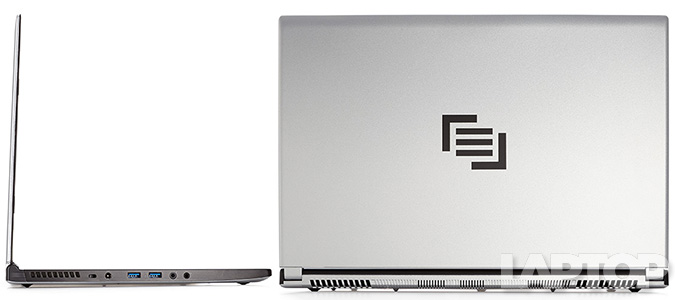
This is one epically silver fox -- at least according to Maingear. As is its tradition, the aluminum lid of the Pulse 15 is coated with one of Maingear's extravagantly named custom automotive paints. In this case, the laptop sports an Epic Silver paint job. The matte silver finish is lovely, although it does invite comparisons to Apple MacBook Pro. In place of the white backlit apple, there's Maingear's black, slightly raised emblem.
If Epic Silver's not your thing, you can dress up your notebook in one of the company's other paint options, which include Furious Fuchsia, Copper Orange, Sapphire Blue or Hunter Green, for an additional $149. There's also a custom color option, which can have a matte or glossy finish, for $199.
MORE: Find the Best Gaming Laptop for You
The majority of the Pulse 15's interior is made from a jet-black aluminum that's cool to the touch. The power button is located at top center of the deck, above the wide speaker grille. Although I've seen this same exact design on the MSI GS60 Ghost, I'm still a fan of this chassis. My favorite part is the recessed keyboard deck with its severe lines leading toward the laptop's front lip.

Weighing 4.6 pounds, the 15.4 x 10.5 x 0.75-inch Pulse 15 is fairly light for a 15-inch notebook. It's only slightly heavier than the Razer Blade 14 (13.6 x 9.3 x 0.7 inches), which weighs 4.4 pounds. The Lenovo Y50-70 Touch, by comparison, measures 15.23 x 10.37 x 0.9 inches and weighs 5.2 pounds, while the Gigabyte P25 delivers bulkier measurements (6.2 pounds, 15.43 x 10.35 x 1.51 inches).
Display
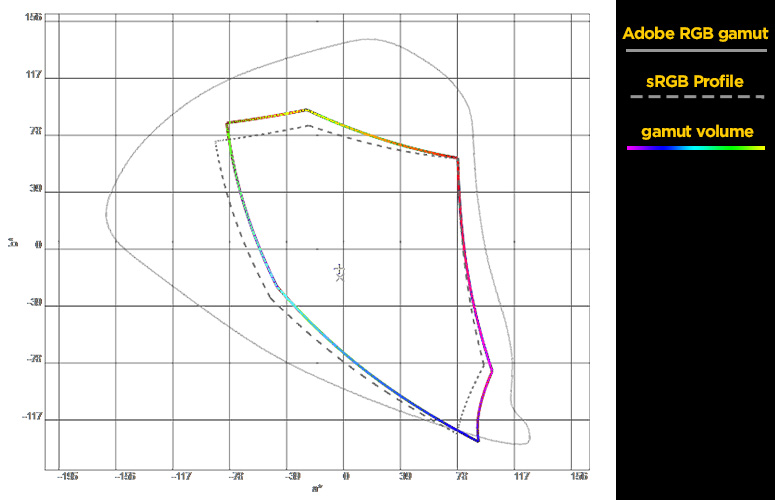
Click to EnlargeThe latest trend with gaming notebooks is to outfit them with ultra-high-resolution displays. The Pulse 15 comes with a magnificent 2880 x 1620 IPS glossy screen that delivers warm colors, sharp details and gloriously wide viewing angles.
During the 4K "Interstellar" trailer, I could see just about every bit of golden stubble on Matthew McConaughey's sun-weathered face as well as the subtle line running across his forehead. It was much brighter than the Lenovo Y50-70 Touch's 3840 x 2160 panel, which gave the actor a more orange hue. McConaughey's electric blue eyes popped, and the reddish orange glow of a fire looked so good you could almost feel heat radiating out.
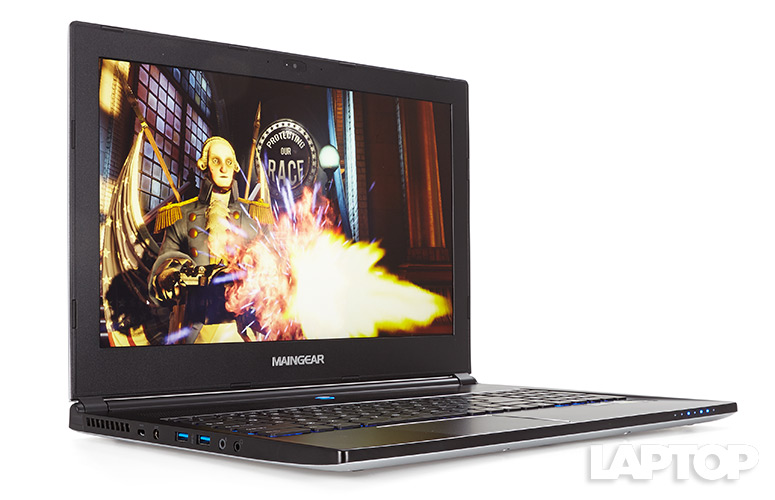
Click to EnlargeDuring my play-through of Castlevania: Lords of Shadow Ultimate Edition, Gabriel's red coat looked darker than usual. The other colors, however, were pretty accurate, particularly the green and blues on the health and magic meter. I was very impressed with the level of detail, such as the way the light flickered across a large rusty gear with its myriad pockmarks, scratches and nicks.
The laptop delivered 289 nits of brightness on our light meter, outshining the 244 nit average. The Blade 14, Gigabyte P25X and Lenovo Y50-70 were dim by comparison with scores of 261, 215 and 190 nits, respectively.
Maingear has a pretty good track record with producing vivid displays, and the Pulse 15 is no different. The laptop hit 101.1 percent on the sRGB color gamut test, which measures color reproduction. That easily beat the 80 percent mainstream average and the P25X's 98 percent. The Blade 14 registered a similar 101.5 percent, but the Y50-70 Touch mustered only 87.2 percent.
The Pulse 15 and the Blade 14 were evenly matched on the Delta-E color accuracy test, as both scored 1.5 (0 is best). That's much better than the category average of 6.8 and the Y50-70 Touch's 2.7. The P25X delivered a near-perfect 0.5.
Audio
I like my notebooks thin -- not my music. During testing, I was disappointed to discover that the Pulse 15's speakers filled my small testing room with loud, albeit hollow audio. As I listened to Marvin Gaye's "Got to Give It Up," the singer's boudoir-soft vocals were harsh and grating at max volume. The bass guitar was barely there, while the cowbell and accompanying percussions were submerged in the background.
The audio on Castlevania sounded distant -- the wicked sound of my whip crashing down upon the head of my undead foe was hollow. The usually deep organ accompanied by heavy strings also sounded pushed back, which took away a big part of the immersion factor.
Despite the hollow presentation, the Pulse hit 91 decibels on the Laptop Mag Audio Test, topping the 87 dB category average. The Blade 14 and Y50-70 weren't too far behind with 88 dB, while the P25X was slightly below average with 84 dB.
Keyboard and Touchpad
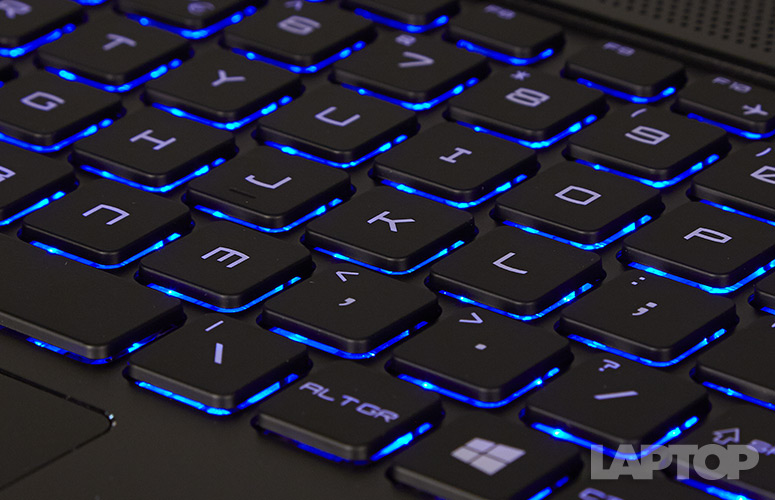
Click to EnlargeBig springy keys with generous spacing -- that's what I look for in a keyboard, and that's what the Pulse 15 delivers in spades. Despite housing a full number pad on the keyboard deck, Maingear still had room for a full-size chiclet keyboard without shrinking any of the keys. The customizable backlighting is bright enough to use in dimly lit spaces.
The keyboard has 1.8mm of key travel (1.5-2mm is acceptable) with 60g of actuation, which translates into a comfortable typing experience. The keys' firm feedback allowed me to peck out 55 words per minute, matching my usual average.
MORE: The Best Gaming Keyboards You Can Buy
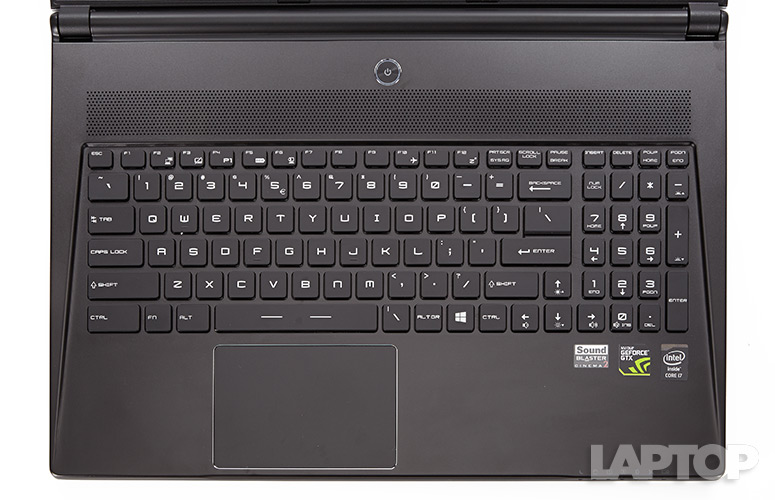
Click to EnlargeMaingear uses MSI's Keyboard LED Manager to configure the keyboard's mesmerizing, pulsating light show. Broken down into three zones, gamers have the ability to assign colors and lighting effects to the keyboard, depending on whether the laptop is in Standard or Idle mode.
Standard Mode provides six lighting effects (Dual Color, Wave, Breathing, Audio, Gaming and Normal, while Idle restricts you to three (Breathing, Wave and Off). Creating a custom lighting profile is fairly simple, but I wish the software offered more lighting choices, similar to the SteelSeries utility or Alienware's stunning AlienFX software.
The Pulse 15 has a spacious 4.1 x 2.75-inch Elan touchpad. The chrome-lined input device delivered smooth Windows 8.1 and multitouch gestures including pinch-zoom, two-finger rotate and three-finger flick. The bottom corners of the touchpad were a little mushy, but got the job done as right and left mouse buttons.
Heat
When you're not taking down hordes of mutants in Metro: Last Light or mountains of the undead in Castlevania: Lords of Shadow, the Pulse 15 keeps things relatively cool. After streaming a full-screen Hulu video for 15 minutes, the touchpad measured 77 degrees. The space between the G and H keys hit 82, while the notebook's bottom had a temperature of 90 degrees.
After 15 minutes of hack, slash and puzzle-solving my way through Castlevania, the touchpad's temperature rose to 81 degrees. The space between the G and H keys measured 94 degrees, just slightly below the Laptop Mag 95-degree comfort threshold. However, the bottom of the laptop, particularly the left vent, blew 154 degrees -- just the right temperature to slow roast a crotch. The center of the notebook's bottom measured a relatively cooler, but still uncomfortable 134 degrees.
Even worse, the notebook's side-mounted fans are very loud as they tried - unsuccessfully -- to bring down the temperature.
Webcam

Click to EnlargeLet this be a lesson: Just because it's 1080p, that doesn't make it good. Snapping pics with the Pulse 15's integrated webcam was a dreary experience. Test photos were particularly dark, draining all the color out of my bright turquoise shirt. Details were so grainy that my colleague Kenneth's red-and-blue-striped shirt turned into an amorphous purple blob.
Ports
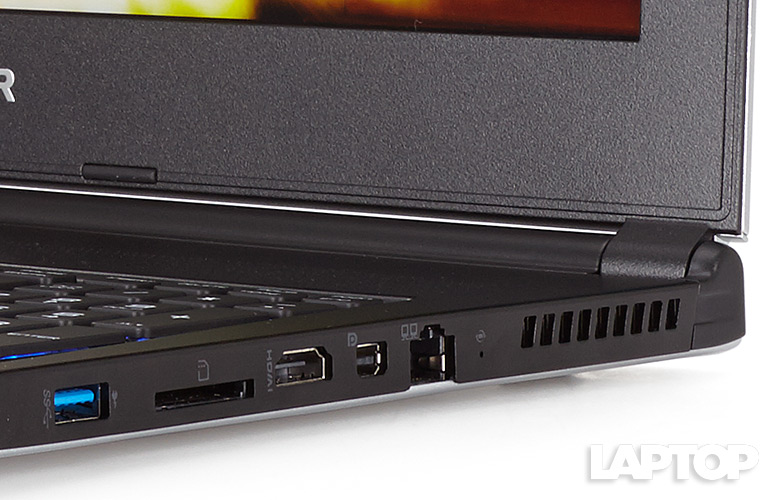
Click to EnlargeLike most slim gaming notebooks, the Pulse 15 serves up a modest portion of ports. You'll find a single USB 3.0 port on the right side along with a SD Card reader, HDMI, mini-DisplayPort and Gigabit Ethernet. There's a pair of USB 3.0 ports on the left with a secure lock slot and jacks for headphones, microphone and power.
Graphics and Gaming
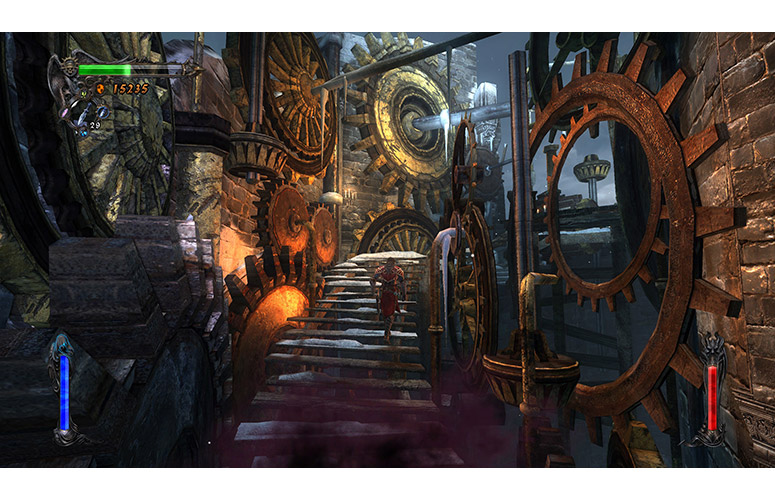
Click to EnlargeMaingear equipped the Pulse 15 with an Nvidia GeForce GTX 870M GPU packing 3GB of VRAM, making this beauty a bona fide beast. I had a blast fighting my way to The Forgotten One in Castlevania: Lords of Shadow. Despite the screen being filled with baddies, the Pulse 15 delivered a steady 45 frames per second at 2880 x 1620 while I cut a swath of destruction.
In those instances that I wasn't grinding out a few levels in Castlevania, the notebook automatically switched over to the Intel HD Graphics 4600 GPU for less resource-intensive tasks, such as watching Animaniacs reruns.
The laptop performed just as well on synthetic benchmarks, scoring 124,218 on 3DMark Ice Storm Unlimited, which measures graphics performance. That was more than enough to beat the 61,036 average as well as the Razer Blade 14 (113,793), which also features an Nvidia 870M GPU. The Nvidia GeForce GTX 860M-powered Lenovo Y50-70 Touch notched 118,124, while the Gigabyte P25X's Nvidia GeForce GTX 880M GPU delivered a stronger 132,272.

During the BioShock Infinite test, the Pulse 15 achieved 128 fps on low at 1080p, more than double the 58 fps average. The Blade 14 was right on its heels with 120 fps. The P25X obtained 151 fps, while the Y570-70 Touch posted 96 fps. On high, the Pulse 15 notched 54 fps, beating the 23 fps average. The Gigabyte P25X, Blade 14 and Y50-70 Touch scored 65 fps, 51 fps and 42 fps, respectively.
Our testing lab pulled out the big guns with the Metro: Last Light benchmark, but like Tim Duncan in a playoff series, the Pulse 15 went hard in the paint. The laptop scored 76 fps on low at 1080p, shattering the 40 fps average. Once again, the Blade 14 was achingly close with 70 fps, while the Y50-70 Touch hit 63 fps. However, the P25X powered through even harder, scoring 86 fps.
MORE: Top Gaming Mice 2014
GeForce Experience
Nvidia's GeForce Experience app includes several features meant to enhance gameplay and endurance. Battery Boost lets you cap performance at a predetermined frame rate. The app will then throttle the notebook's components, so that gamers can eke out a bit more juice without sacrificing too much performance. Battery Boost Custom Game Settings will let you tweak individual titles even further.
ShadowPlay lets you record gameplay at resolutions of up to 1920 x 1080p, and broadcast gaming sessions to sites such as Twitch.
GameStream, previously only available on Nvidia's desktop GPUs, allows you to stream games from your notebook to connected devices, such as Nvidia's SHIELD.
Performance
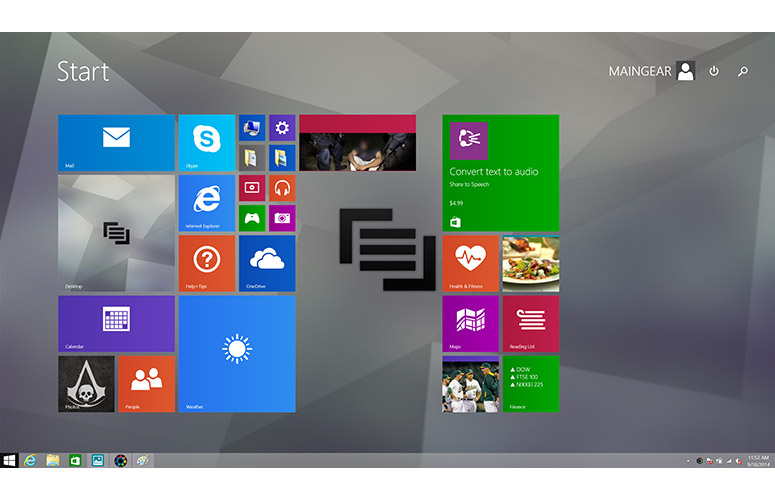
Click to EnlargeWhether you're fragging or crunching numbers, the Maingear Pulse 15 is a portable powerhouse. The laptop's 2.5-GHz Intel Core i7-4710HQ processor easily streamed an episode of Bojack Horseman on Netflix with 13 open tabs of Google Chrome, Internet Explorer and Mozilla Firefox while performing a system scan.
On its march to laptop domination, the Pulse 15 posted 13,073 on the Geekbench 3 test, which measures overall performance. The Lenovo Y50-70 Touch, which also has a 2.5-GHz Intel Core i7-4710HQ CPU, hit 12,748, while the Gigabyte P25X's 2.8-GHz Intel Core i7-4810MQ CPU notched 14,124. The Razer Blade 14 and its 2.2-GHz Intel Core i7-4702HQ CPU delivered 11,928. All cruised past the mainstream 8,429 category average.
Talk about a speedy pulse! The laptop's dual 128GB SSDs in SuperRAID configuration with a 1TB 7,200-rpm hard drive duplicated 4.97GB of multimedia files in 19 seconds. That translates to a transfer rate of 268 MBps, which easily tops the 78.1 MBps average. While impressive, it wasn't enough to outpace the P25X (256GB SSD and 1TB, 7,200-rpm hard drive), which obtained 299.4 MBps. The Blade 14 and the Y50-70 Touch, which both have 256GB SSDs, notched a slower 154.2 MBps and 42 MBps, respectively.
The Pulse 15 took 13 seconds to boot Windows 8.1, which is noticeably faster than the 20-second average and matches the Y50-70 Touch. However, the Gigabyte P25X and Razer Blade 14 were a tad faster at 9 and 10 seconds each.
The Pulse 15 paired 20,000 names and addresses in 3 minutes and 54 seconds during the OpenOffice Spreadsheet Macro test. That's faster than the 5:28 average, the Razer Blade 14 (4:15) and the Lenovo Y50-70 Touch (3:59). However, the P25X was the first to cross the finish line, posting a time of 3:34.
Battery Test
With all that power under the hood, you know there's going to be some kind of trade-off. The Maingear Pulse 15 lasted just 3 hours and 39 minutes on the Laptop Battery Test (continuous Web surfing over Wi-Fi at 100 nits). That's well below the 7:18 mainstream average, but the Lenovo Y50-70 Touch didn't fare much better at 3:40. The Razer Blade 14 and P25X held out the longest with times of 5:19 and 7:22, respectively.
MORE: 10 Laptops with the Longest Battery Life
Software and Warranty
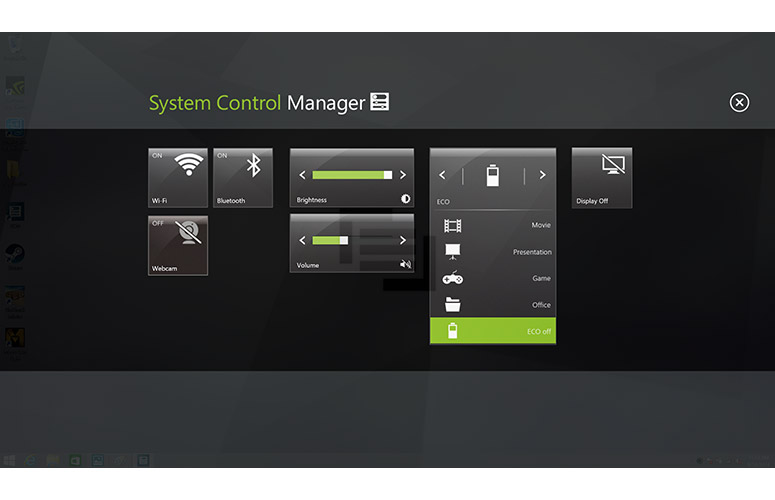
Click to EnlargeBloatware? What bloatware? Outside of the System Control Manager, which allows you to adjust Wi-Fi, Webcam, Brightness and Power settings, the Pulse is virtually free of all third-party software. Maingear also included the usual Windows 8.1 applications (Email, Skype, Calendar and News).
The Maingear Pulse 15 comes with a Lifetime Angelic Service Labor and Phone Support with a 1-year comprehensive warranty.
Configurations
My review unit of the Maingear Pulse 15 costs $2,474 and is outfitted with a 2.5-GHz Intel Core i7-4710HQ processor with 16GB of RAM, dual 128GB SSDs in SuperRAID configuration with a 1TB 7,200-rpm hard drive, Intel HD Graphics 4600 GPU and an Nvidia GeForce GTX 870M GPU with 3GB of VRAM.
The starting configuration costs $2,199 and features a 2.5-GHz Intel Core i7-4710HQ processor, 16GB of RAM, a 128GB mSATA SSD, a 1TB 7,200-rpm hard drive, Intel HD Graphics 4600 GPU and an Nvidia GeForce GTX 870M GPU with 3GB of VRAM.
Each of these configurations comes with a glossy 2880 x 1620 IPS display.
Bottom Line
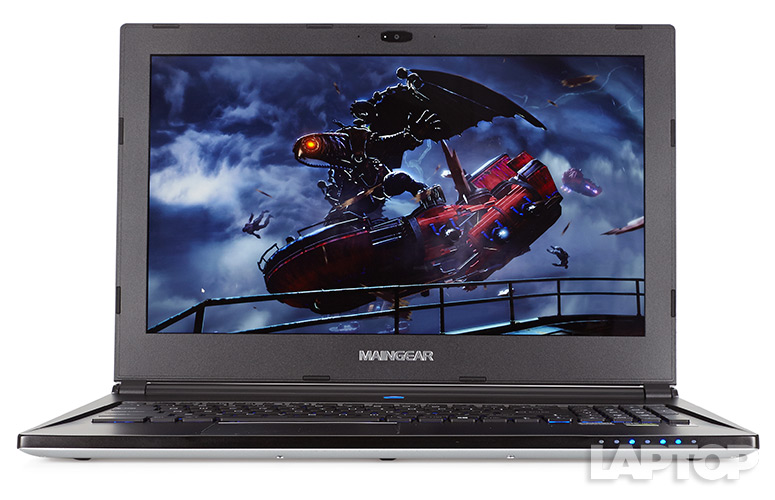
Click to EnlargeMaingear's svelte dynamo is nothing short of impressive. The $2,474 Pulse 15 combines powerful specs, including Nvidia GTX 8870M graphics and a Core i7 CPU with a wide-angle, Retina-like display in a slim chassis. When it came to performance, the laptop didn't slice through demanding games (and spreadsheets) without prejudice.
However, the high temperatures and high price tag will make some gamers hit pause. The $2,399 Razer Blade 14 has similar specs with a smaller but even higher resolution display. For $1,649, the Gigabyte P25X is chunkier and has a lower resolution screen, but offers even better performance and longer battery life. But if power and portability are tantamount, the Maingear Pulse 15 is the best slim 15-inch gaming laptop on the market.
Maingear Pulse 15 Specs
| Bluetooth | Bluetooth 4.0 |
| Brand | Maingear |
| CPU | 2.5-GHz Intel Core i7 4710HQ |
| Card Slots | SD memory reader |
| Company Website | www.maingear.com |
| Display Size | 15.6 |
| Graphics Card | Nvidia GeForce GTX 870M |
| Hard Drive Size | Dual 128GB |
| Hard Drive Speed | n/a |
| Hard Drive Type | Dual SSDs |
| Native Resolution | 2880 x 1620 |
| Operating System | Windows 8.1 |
| Optical Drive | None |
| Optical Drive Speed | n/a |
| Ports (excluding USB) | Mini DisplayPort, Microphone, HDMI, Gigabit Ethernet, security lock slot, USB 3.0, SD card slot |
| RAM | 16GB |
| Secondary Hard Drive Size | 1TB |
| Secondary Hard Drive Speed | 7,200 |
| Secondary Hard Drive Type | SATA Hard Drive |
| Size | 15.4 x 10.5 x 0.75 inches |
| Touchpad Size | 4.1 x 2.75 inches |
| USB Ports | 3 |
| Video Memory | 3GB |
| Warranty/Support | Lifetime Angelic Service Labor and Phone Support with 1 Year Comprehensive Warranty |
| Weight | 4.6 pounds |
| Wi-Fi | 802.11ac |
| Wi-Fi Model | Intel Dual Band Wireless-AC |

Sherri L. Smith has been cranking out product reviews for Laptopmag.com since 2011. In that time, she's reviewed more than her share of laptops, tablets, smartphones and everything in between. The resident gamer and audio junkie, Sherri was previously a managing editor for Black Web 2.0 and contributed to BET.Com and Popgadget.
